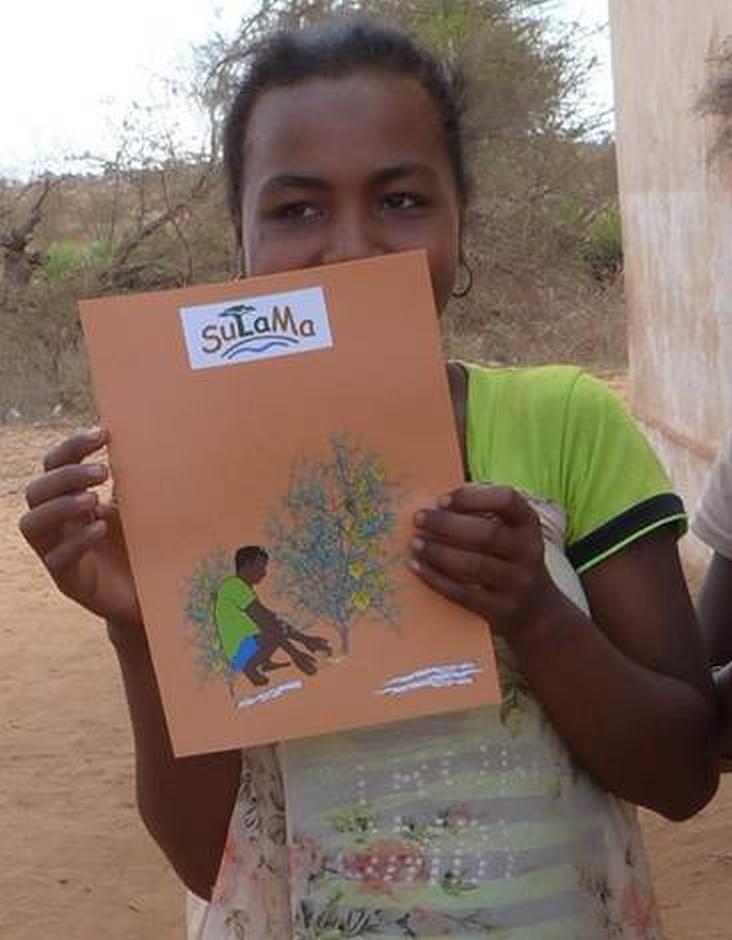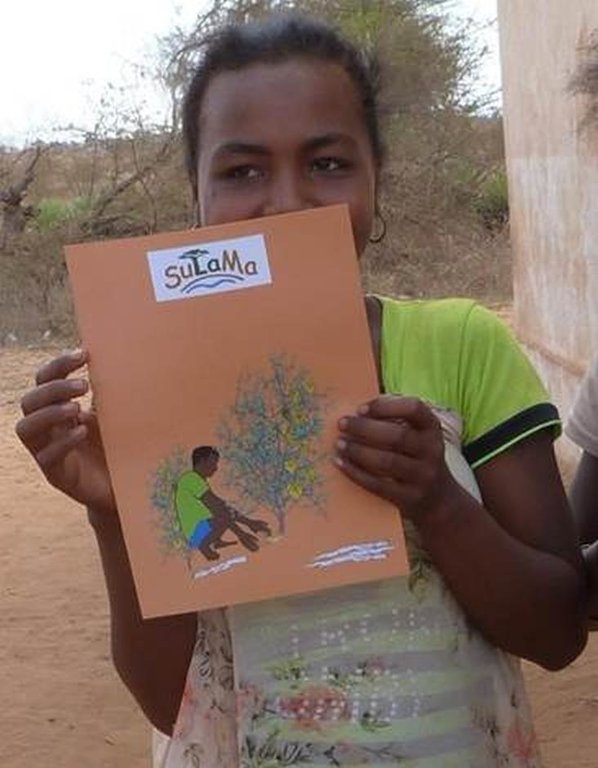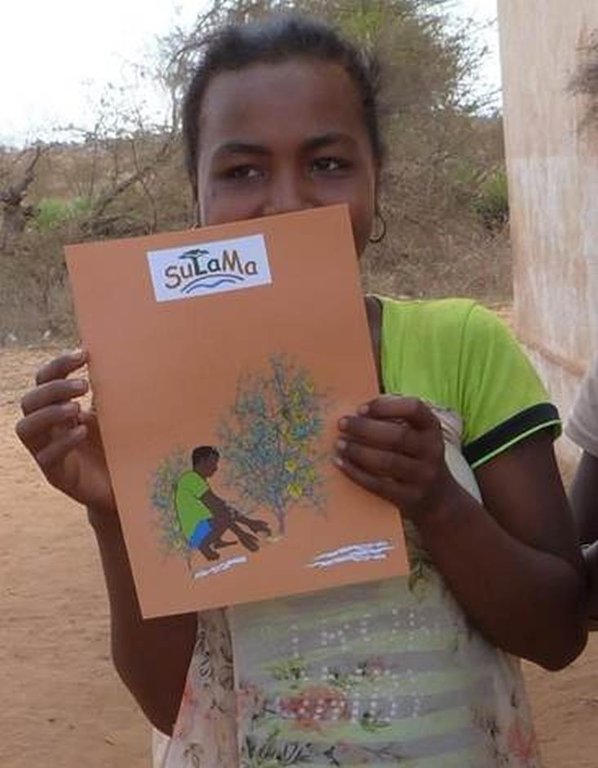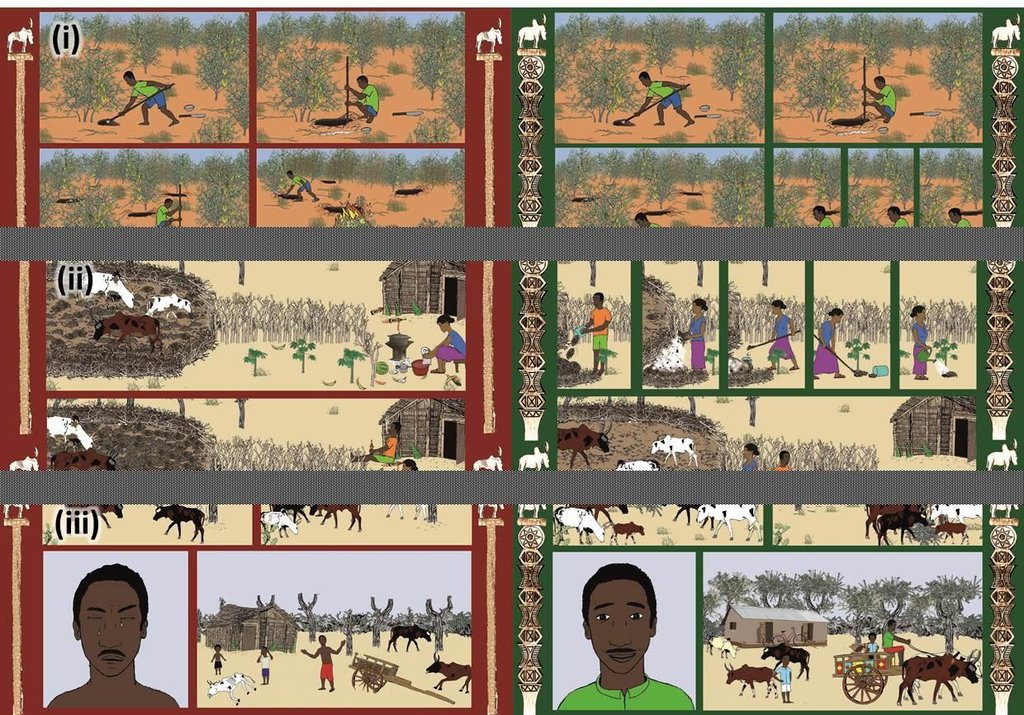Increasing environmental awareness using comic-style illustrations as a visual communication tool [ມາດາກັສກາ]
- ການສ້າງ:
- ປັບປູງ:
- ຜູ້ສັງລວມຂໍ້ມູນ: Tobias Feldt
- ບັນນາທິການ: –
- ຜູ້ທົບທວນຄືນ: Fabian Ottiger, Deborah Niggli
approaches_2545 - ມາດາກັສກາ
ເບິ່ງພາກສ່ວນ
ຂະຫຍາຍທັງໝົດ ຍຸບທັງໝົດ1. ຂໍ້ມູນທົ່ວໄປ
1.2 ລາຍລະອຽດ ການຕິດຕໍ່ ຂອງບຸກຄົນທີ່ຊັບພະຍາກອນ ແລະ ສະຖາບັນ ການມີສ່ວນຮ່ວມ ໃນການປະເມີນຜົນ ແລະ ເອກະສານ ຂອງວິທີທາງ
ຜູ້ຊ່ຽວຊານ ດ້ານການຄຸ້ມຄອງ ທີ່ດິນແບບຍືນຍົງ:
Weiss David
mail@david-weiss.com
David Weiss Agrarcomics
Kirchstraße 18, D-37214 Witzenhausen http://david-weiss.com
ເຢຍລະມັນ
ຊື່ຂອງໂຄງການ ທີ່ອໍານວຍຄວາມສະດວກ ໃນການສ້າງເອກກະສານ ຫຼື ປະເມີນດ້ານແນວທາງ (ຖ້າກ່ຽວຂ້ອງ)
Sustainable Landmanagement in south-western Madagascar (SuLaMa / GLUES)ຊື່ຂອງໂຄງການ ທີ່ອໍານວຍຄວາມສະດວກ ໃນການສ້າງເອກກະສານ ຫຼື ປະເມີນດ້ານແນວທາງ (ຖ້າກ່ຽວຂ້ອງ)
Book project: Making sense of research for sustainable land management (GLUES)ຊື່ຂອງ ສະຖາບັນການຈັດຕັ້ງ ທີ່ອໍານວຍຄວາມສະດວກ ໃນການສ້າງເອກກະສານ ຫຼື ປະເມີນແນວທາງ (ຖ້າກ່ຽວຂ້ອງ)
Universität Kassel - ເຢຍລະມັນ1.3 ເງື່ອນໄຂ ຂອງການນໍາໃຊ້ເອກກະສານຂໍ້ມູນ ຂອງ WOCAT
ເມື່ອໃດທີ່ໄດ້ສັງລວມຂໍ້ມູນ (ຢູ່ພາກສະໜາມ)?
01/10/2015
ຜູ້ສັງລວມ ແລະ ບັນດາຜູ້ຕອບແບບສອບຖາມ ຍອມຮັບໃນເງື່ອນໄຂ ການນໍາໃຊ້ຂໍ້ມູນເອກະສານ ທີ່ສ້າງຂື້ນ ໂດຍຜ່ານ ອົງການ WOCAT:
ແມ່ນ
1.4 ເອກະສານອ້າງອີງ (ຫຼາຍ) ກັບແບບສອບຖາມ (ຫຼາຍ) ເຕັກໂນໂລຢີ ຂອງດ້ານການຄຸ້ມຄອງ ດິນແບບຍືນຍົງ
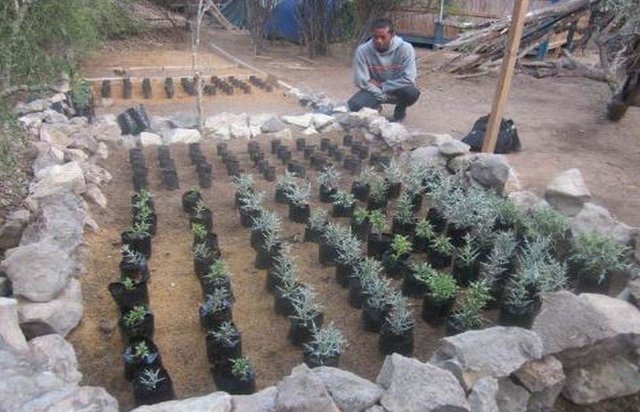
Sustainable propagation of the fodder tree Euphorbia stenoclada … [ມາດາກັສກາ]
Propagation of “samata” cuttings for long-term provision of supplementary livestock fodder to reduce the pressure on natural vegetation.
- ຜູ້ສັງລວມຂໍ້ມູນ: Johanna Goetter
2. ພັນລະນາ ແນວທາງການຄຸ້ມຄອງນໍາໃຊ້ດິນແບບຍືນຍົງ
2.1 ການອະທິບາຍ ໂດຍຫຍໍ້ ຂອງວິທີທາງ
Communicating and transferring scientific results and recommendations about sustainable land management to local people
2.2 ການອະທິບາຍ ລາຍລະອຽດ ຂອງວິທີທາງ
ການອະທິບາຍ ລາຍລະອຽດ ຂອງວິທີທາງ:
Aims / objectives: The central aim of this approach was to increase environmental awareness in the Mahafaly region of southwestern Madagascar using visual communications tools. Comic-style illustrations were originally designed to communicate scientific recommendations on sustainable land management (SLM) and to ensure knowledge transfer from scientists to local people.
Methods: Visual communication, based on pictures, drawings, movies, sequential images and posters plays a vital role in countries where many people are illiterate. Another advantage is its easy reproduction in comparison to oral communication. It may also transfer knowledge where oral communication fails because of linguistic barriers or simply because complex narratives and messages are easier to explain visually than orally. In the context of a participatory research project to support SLM on the Mahafaly Plateau in southwestern Madagascar, comic-style illustrations of visual narratives were used to focus on environmental problems and SLM strategies. Since cross-cultural differences arise in “visual languages” globally, the visualization style needs to be carefully selected. Furthermore, misunderstanding of visual narratives may occur when objects are drawn not realistically enough, or if the statement is abstract or only presented from a scientific The central aim point of view. To avoid misinterpretation and increase readability and local acceptance, the style of comics was specifically designed for the conditions in rural Madagascar using a traditional Malagasy art style (sepulchre art in the form of “Aloalo” tomb sculptures). Comic illustrations were prepared to show the impact of different land use practices on the environment and local livelihoods using two contrasting stories/scenarios. The “red story” depicts a worst case scenario of unsustainable practices that are often applied by local inhabitants and the “green story” shows an example of a best case scenario based on an alternative, sustainable land management option recommended by scientific experts. To keep the stories simple and understandable, there was a focus on scientific key messages which can be easily transformed into visual narratives - and technical details were left aside.
Stages of implementation: The six year (2011-2016) transdisciplinary research consortium of Malagasy and German universities was initiated in the Mahafaly region of southwestern Madagascar in order to support sustainable land management (SuLaMa = Sustainable Land Management in southwestern Madagascar). Based on scientific research regarding the diversity and local use of forest resources and SLM practices in animal and crop husbandry, key messages and recommendations, which were easy to implement, were formulated by the scientific experts. Two examples of overused natural resources and one example of a neglected soil improvement practice were chosen for comic-style illustrations and transformed to visual narratives. These are (i) sustainable harvesting practice of wild yams (Dioscorea bemandry); (ii) composting of manure and its application to improve soil fertility and yields in home gardens; and (iii) sustainable utilization of the succulent tree Euphorbia stenoclada (called 'samata' in the local dialect) as supplementary forage for livestock. During an inception phase for the implementation of visual narratives in the study region, different drawing styles were tested and assessed to gather information on the local perception of art. Drawing styles showing the highest acceptance rate and readability were subsequently used to prepare the comics. The comics were printed on robust clay coated paper and handed out to local inhabitants during larger village workshops, where the different stories were presented and discussed.
2.3 ຮູບພາບຂອງແນວທາງ
2.5 ປະເທດ / ເຂດ / ສະຖານທີ່ບ່ອນທີ່ແນວທາງໄດ້ຖືກນໍາໃຊ້
ປະເທດ:
ມາດາກັສກາ
ພາກພື້ນ / ລັດ / ແຂວງ:
Atsimo-Andrefana (South-West Madagascar)
ຂໍ້ມູນເພີ່ມເຕີມຂອງສະຖານທີ່:
Toliara II
2.6 ວັນທີເລີ່ມຕົ້ນ ແລະ ສິ້ນສຸດ ການຈັດຕັ້ງປະຕີບັດ ວິທີທາງ
ສະແດງປີຂອງການເລີ່ມຕົ້ນ:
2015
ປີທີ່ສີ້ນສູດ (ຖ້າຢຸດບໍ່ໄດ້ນໍາໃຊ້ ວິທີທາງ):
2016
2.7 ປະເພດຂອງແນວທາງ
- ພາຍໃຕ້ໂຄງການ / ແຜນງານ
2.8 ເປົ້າໝາຍ / ຈຸດປະສົງຫຼັກ ຂອງການຈັດຕັ້ງປະຕິບັດ ວິທີທາງ
The Approach focused mainly on SLM with other activities (sustainable land use, livestock husbandry, crop production, yams)
Comic-style illustrations were designed for environmental education purposes to communicate scientific results and recommendations on sustainable land management and ensure knowledge transfer from scientific experts to local people. It is the general aim of the approach to raise awareness for sustainable land use and environmental protection and therefore to improve both people's livelihoods and the efficiency in the use of natural resources.
The SLM Approach addressed the following problems: The approach area is characterized by low agricultural production, a lack of technical knowledge, low education level and conflicts over resource use.
2.9 ເງື່ອນໄຂອໍານວຍ ຫຼື ຂັດຂວາງການປະຕິບັດຂອງເຕັກໂນໂລຢີ / ເຕັກໂນໂລຢີການນໍາໃຊ້ຕາມແນວທາງ
ສັງຄົມ / ວັດທະນະທໍາ / ມາດຕະຖານ ແລະ ຄຸນຄ່າທາງສາສະໜາ
- ເຊື່ອງຊ້ອນ
People in the project area have a cultural reservation towards the utilization of animal dung, thus renouncing one of the fundamental principles for soil amelioration. At the same time, the declination of handling the animals' feces and therefore hardly ever cleaning their night enclosures strogly increases the risk of epizootic diseases and parasite infections.
Treatment through the SLM Approach: The comic drawings attempt to demonstrate how simple measures may have a sustainable impact in improving people’s livelihoods in many ways. They will at best be food-for-thought to reconsider culture-based practices that are not good SLM practice.
ກ່ຽວກັບກົດໝາຍ (ສິດນໍາໃຊ້ດິນ, ສິດນໍາໃຊ້ນໍ້າ)
- ເຊື່ອງຊ້ອນ
With regard to the sustainable utilization of fodder trees, land ownership conflicts may arise as most of these trees around settlements stand on private ground – but without clear demarcation.
Treatment through the SLM Approach: Where currently there only exist single cactus plants or other hardly recognisable natural markings between plots, clear boundary lines between those plots could be illustrated as a good alternative in the respective comic.
The existing land ownership, land use rights / water rights hindered a little the approach implementation Some contents presented in the comic drawings, such as on the sustainable utilization of fodder trees, can conflict with land ownerships as most of these trees around settlements stand on private ground. Boundary lines between these plots, often only consisting of single cactus plants or other natural markings, may not be recognizable for outsiders but have to be included into the comics to avoid missunderstandings.
ວຽກ, ມີກໍາລັງຄົນ
- ເຊື່ອງຊ້ອນ
Local people often do not see a direct benefit from higher workload e.g. by a more careful harvesting of forest products, the cleaning of livestock enclosures, or the utilization of manure for soil amelioration.
Treatment through the SLM Approach: The approach aims to show plainly the positive and sustainable impact of the alternative practices and the effect on people’s livelihoods.
ອື່ນໆ
- ເຊື່ອງຊ້ອນ
The concept of some natural resources being finite is not very widespread among the local population.
Treatment through the SLM Approach: The approach may help local people to become more aware of this problem and to induce the
establishment of more sustainable land use practices.
3. ການມີສ່ວນຮ່ວມ ແລະ ບົດບາດຂອງພາກສ່ວນທີ່ກ່ຽວຂ້ອງທີ່ໄດ້ມີສ່ວນຮ່ວມ
3.1 ຜູ້ມີສ່ວນຮ່ວມ ໃນວິທີທາງ ແລະ ພາລະບົດບາດ ຂອງເຂົາເຈົ້າ
- ຜູ້ນໍາໃຊ້ດິນໃນທ້ອງຖິ່ນ / ຊຸມຊົນທ້ອງຖິ່ນ
Crop and livestock farmers
Livestock related topics were addressed to male farmers as they are mainly involved in livestock husbandry.
- ອົງການຈັດຕັ້ງ ທີ່ບໍ່ຂື້ນກັບລັດຖະບານ
- ອໍານາດ ການປົກຄອງທ້ອງຖິ່ນ
municipality, village
- ພະນັກງານຂັ້ນສູນກາງ (ຜູ້ວາງແຜນ, ຜູ້ສ້າງນະໂຍບາຍ)
- ອົງການຈັດຕັ້ງ ສາກົນ
3.2 ການມີສ່ວນຮ່ວມຂອງຜູ້ນໍາໃຊ້ທີ່ດິນໃນທ້ອງຖິ່ນ / ຊຸມຊົນທ້ອງຖິ່ນໃນໄລຍະທີ່ແຕກຕ່າງກັນຂອງແນວທາງ
| ການລວບລວມ ເອົາຜູ້ນໍາໃຊ້ດິນ ໃນທ້ອງຖິ່ນ / ຊຸມຊົນທ້ອງຖິ່ນ | ໃຫ້ລະບຸ ຜູ້ໃດທີ່ມີສ່ວນຮ່ວມ ໃນແຕ່ລະກິດຈະກໍາ? | |
|---|---|---|
| ການເລີ່ມຕົ້ນ / ແຮງຈູງໃຈ | ບໍ່ມີ | |
| ການວາງແຜນ | ການຮ່ວມມື | data surveys, questionnaires, group discussions |
| ການປະຕິບັດ | ການຊ່ວຍເຫຼືອຈາກພາຍນອກ | village workshops to present the comics and to explain the storylines. |
| ຕິດຕາມກວດກາ / ການປະເມີນຜົນ | ການຮ່ວມມື | stepwise evaluation and improvement of comic understanding and acceptance by land users and the community |
| Research | ການບໍ່ປະຕິບັດ |
3.3 ແຜນວາດ (ຖ້າມີ)
ການອະທິບາຍ:
Extracts of three storylines on (i) yams harvesting, (ii) manure composting and (iii) the utilization of ‘samata’ (Euphorbia stenoclada)
ຜູ້ຂຽນ:
D. Weiss
3.4 ການຕັດສິນໃຈກ່ຽວກັບການຄັດເລືອກເຕັກໂນໂລຢີຂອງການຄຸ້ມຄອງທີ່ດິນແບບຍືນຍົງ / ເຕັກໂນໂລຢີ
ລະບຸ ຄົນທີ່ຕັດສິນໃຈ ກ່ຽວກັບການຄັດເລືອກຂອງ ເຕັກໂນໂລຢີ / ເຕັກໂນໂລຢີ ຈະໄດ້ຮັບການປະຕິບັດ:
- ຜູ້ຊ່ຽວຊານ ຫຼັກດ້ານການຄຸ້ມຄອງ ທີ່ດິນແບບຍືນຍົງ, ມີການຕິດຕາມປຶກສາຫາລືກັບຜູ້ນໍາໃຊ້ທີ່ດິນ
ອະທິບາຍ:
During the six-year term of the original project, researchers gained a deep inside into the daily routine and workflow of the local population. The technology approach was therefore based on this knowledge and aimed at some of the major problems identified.
Decisions on the method of implementing the SLM Technology were made by mainly by SLM specialists with consultation of land users
4. ການສະໜັບສະໜູນທາງດ້ານວິຊາການ, ການສ້າງຄວາມສາມາດ, ແລະ ການຈັດການຄວາມຮູ້.
4.1 ການສ້າງຄວາມສາມາດ / ການຝຶກອົບຮົມ
ຜູ້ນໍາໃຊ້ທີ່ດິນ ຫຼື ພາກສ່ວນກ່ຽວຂ້ອງອື່ນໆ ໄດ້ຮັບການຝຶກອົບຮົມບໍ່?
ແມ່ນ
ໃຫ້ລະບຸ ຜູ້ໃດທີ່ໄດ້ຮັບການຝຶກອົບຮົມ:
- ຜູ້ນໍາໃຊ້ດິນ
- ພະນັກງານພາກສະໜາມ / ທີ່ປຶກສາ
ຮູບແບບຂອງການຝຶກອົບຮົມ:
- ເນື້ອທີ່ສວນທົດລອງ
- ກອງປະຊຸມ
4.2 ການບໍລິການໃຫ້ຄໍາປຶກສາ
ເຮັດຜູ້ໃຊ້ທີ່ດິນມີການເຂົ້າເຖິງການບໍລິການໃຫ້ຄໍາປຶກສາ?
ແມ່ນ
4.3 ສະຖາບັນການສ້າງຄວາມເຂັ້ມແຂງ (ການພັດທະນາອົງການຈັດຕັ້ງ)
ສະຖາບັນ ໄດ້ຮັບການສ້າງຕັ້ງຂື້ນ ຫຼື ໄດ້ຮັບການສ້າງຄວາມເຂັ້ມແຂງ ໂດຍການຈັດຕັ້ງປະຕິບັດ ວິທີທາງບໍ່?
- ມີ, ພໍສົມຄວນ
ລະບຸ ທາງສະຖາບັນ ໄດ້ສ້າງຄວາມເຂັ້ມແຂງ ໃນລະດັບໃດ (ຫຼາຍ):
- ທ້ອງຖິ່ນ
ລະບຸ ປະເພດ ຂອງສະໜັບສະໜູນ:
- ທາງດ້ານການເງິນ
- ການສ້າງຄວາມອາດສາມາດ / ການຝຶກອົບຮົມ
- ອຸປະກອນ
ໃຫ້ລາຍລະອຽດເພີ່ມເຕີມ:
Local schools can be equipped with material and practical training courses can be developed with the collaboration of teachers, village chiefs and elders.
4.4 ຕິດຕາມກວດກາ ແລະ ປະເມີນຜົນ
ການຈັດຕັ້ງປະຕິບັດ ວິທີທາງ ໄດ້ມີການປະເມີນຜົນ ແລະ ຕິດຕາມບໍ?
ແມ່ນ
ຄວາມຄິດເຫັນ:
technical aspects were regular monitored by project staff through observations; indicators: Data on land use practices were collected.
technical aspects were regular monitored by project staff through measurements; indicators: Data on human well-being and social conventions (customs, traditions, rituals) were collected.
socio-cultural aspects were regular monitored by project staff, land users through observations; indicators: Comics were distributed to land users and discussed with representatives of 15 villages.
no. of land users involved aspects were ad hoc monitored by None through observations
Evaluation aspects were ad hoc monitored by project staff through observations; indicators: evaluation of understanding and acceptance of comics
There were several changes in the Approach as a result of monitoring and evaluation: The understanding of the comics, their acceptance and the possible implementation of the land use approaches still have to be investigated during a follow-up evaluation process. There were few changes in the technologies. This still needs to be investigated during the evaluation process.
There were few changes in the Technology as a result of monitoring and evaluation: This still needs to be investigated during the evaluation process.
4.5 ການຄົ້ນຄວ້າ
ນີ້້ແມ່ນສ່ວນໜຶ່ງ ການຄົ້ນຄວ້າ ຂອງວິທີທາງບໍ່?
ແມ່ນ
ລະບຸ ຫົວຂໍ້:
- ສັງຄົມ
- ເສດຖະສາດ / ການຕະຫຼາດ
- ລະບົບນິເວດ
- ເຕັກໂນໂລຢີ
ໃຫ້ຂໍ້ມູນ ເພີ່ມເຕີມ ແລະ ກໍານົດ ຜູ້ໃດເຮັດການຄົ້ນຄວ້າ:
Research was carried out on-farm
5. ການສະໜັບສະໜູນທາງດ້ານການເງິນ ແລະ ອຸປະກອນຈາກພາຍນອກ
5.1 ງົບປະມານປະຈໍາປີ ສໍາລັບວິທີທາງ ຂອງການຄຸ້ມຄອງ ທີ່ດິນແບບຍືນຍົງ
ຖ້າຫາກບໍ່ຮູ້ຈັດງົບປະມານທີ່ແນ່ນອນ ແມ່ນໃຫ້ປະມານເອົາ:
- 2,000-10,000
ຄໍາເຫັນ (ຕົວຢ່າງ: ແຫຼ່ງຂໍ້ມູນຫຼັກ ຂອງການສະໜອງທຶນ / ຜູ້ໃຫ້ທຶນທີ່ສໍາຄັນ):
Approach costs were met by the following donors: government (German Federal Ministry of Education and Research (BMBF)): 100.0%
5.2 ການສະໜັບສະໜູນ ທາງດ້ານການເງິນ / ອຸປະກອນ ສະໜອງໃຫ້ແກ່ຜູ້ນໍາທີ່ດິນ
ຜູ້ນໍາໃຊ້ດິນ ໄດ້ຮັບການສະໜັບສະໜູນ ທາງດ້ານ ການເງິນ / ອຸປະກອນ ໃນການຈັດຕັ້ງປະຕິບັດ ເຕັກໂນໂລຢີບໍ?
ແມ່ນ
5.3 ເງິນສົມທົບສໍາລັບການນໍາໃຊ້ສະເພາະປັດໃຈຂາເຂົ້າໃນການຜະລີດກະສິກໍາ (ລວມທັງແຮງງານ)
- ອຸປະກອນ
| ໃຫ້ລະບຸໄດ້ຮັບການສະໜັບສະໜູນປັດໃຈຂາເຂົ້າຫຍັງແດ່ | ທີ່ຂອບເຂດ | ລະບຸ ການອຸດໜູນ |
|---|---|---|
| drawing material (pens and paper) | ງົບປະມານເຕັມສ່ວນ | |
ຖ້າແຮງງານ ຂອງຜູ້ນໍາໃຊ້ດິນ ໄດ້ຮັບການສະໜັບສະໜູນ ປັດໃຈຂາເຂົ້າ, ແມ່ນບໍ່:
- ການອາສາ
ຄວາມຄິດເຫັນ:
Travel expenses for the field trip of the comic illustrator was covered by the project
5.4 ສິນເຊື່ອ
ໄດ້ປ່ອຍສິນເຊື່ອ ສະໜອງໃຫ້ພາຍໃຕ້ ວິທີການສໍາລັບກິດຈະກໍາ ການຄຸ້ມຄອງ ທີ່ດິນແບບຍືນນຍົງບໍ່?
ບໍ່ແມ່ນ
6. ວິເຄາະຜົນກະທົບ ແລະ ສັງລວມບັນຫາ
6.1 ຜົນກະທົບຂອງແນວທາງ
This still needs to be investigated during the evaluation process.
This still needs to be investigated during the evaluation process.
ການຈັດຕັ້ງປະຕິບັດ ວິທີທາງ ສາມາດປັບປຸງ ປະເດັນການຖືຄອງທີ່ດິນ / ສິດທິໃນການນໍາໃຊ້ທີ່ດິນ ທີ່ເຊື່ອງຊ້ອນໃນການຈັດຕັ້ງປະຕິບັດ ເຕັກໂນໂລຢີ ການຄຸ້ມຄອງ ທີ່ດິນແບບຍືນຍົງໄດ້ບໍ?
- ບໍ່
- ມີ, ໜ້ອຍໜຶ່ງ
- ມີ, ພໍສົມຄວນ
- ມີ, ຫຼາຍ
This still needs to be investigated during the evaluation process.
6.2 ແຮງຈູງໃຈຫຼັກຂອງຜູ້ນໍາໃຊ້ທີ່ດິນໃນການປະຕິບັດການຄຸ້ມຄອງທີ່ດິນແບບຍືນຍົງ
- ການຜະລິດເພີ່ມຂຶ້ນ
- ກໍາໄລເພີ່ມຂຶ້ນ (ຄວາມສາມາດ), ການປັບປຸງຄ່າໃຊ້ຈ່າຍ, ຜົນປະໂຫຍດ, ອັດຕາສ່ວນ
- ກຽດສັກສີ, ຄວາມກົດດັນທາງສັງຄົມ / ການຕິດຕໍ່ກັນທາງສັງຄົມ
- ຄວາມຮັບຮູ້ ທາງສີ່ງແວດລ້ອມ
- well-being and livelihoods improvement
6.3 ຄວາມຍືນຍົງຂອງກິດຈະກໍາວິທີທາງ
ຜູ້ນໍາໃຊ້ ທີ່ດິນ ສາມາດສືບຕໍ່ ການຈັດຕັ້ງປະຕິບັດ ຜ່ານວິທີທາງໄດ້ບໍ່ (ໂດຍປາດສະຈາກ ການຊ່ວຍເຫຼືອ ຈາກພາກສ່ວນພາຍນອກ)?
- ແມ່ນ
ຖ້າ ໄດ້, ອະທິບາຍເຫດຜົນ:
Land users can implement the technologies presented in the comics without further help. However for additional applications, new case-specific comic drawings will have to be prepared as the land users may not be able to transmit messages about other practices.
6.4 ຈຸດແຂງ / ຂໍ້ດີ ຂອງວິທີທາງ
| ຈຸດແຂງ / ຂໍ້ດີ / ໂອກາດໃນການນໍາໃຊ້ທີ່ດິນ |
|---|
| Structured surveys carried out after the distribution of the material showed that local people understood and generally accepted the comic stories. |
| ຈຸດແຂງ / ຈຸດດີ / ໂອກາດ ຈາກທັດສະນະຂອງຜູ້ປ້ອນຂໍ້ມູນ ຫຼື ບຸກຄົນສຳຄັນ |
|---|
| This approach has great potential for communication of any knowledge not only scientific. It should be further supported and widely used especially in rural areas with low literacy but not only there. Pictures have a great impact on peoples’ perception and messages can be easier memorized. |
| The more the pictures correspond with reality, the better is the “readability” and identification. The fewer the needless details shown, the better the recognition. |
| The environmental education material offers various possibilities of application, e.g. in schools or during village meetings. It can be used by the local communities over a long period of time. |
| As soon as an appropriate illustration style is found, various topics can be supplemented and more complex subjects can be depicted in greater detail. Individual comic strips may form the base for a more comprehensive but well understandable and adoptable compendium. |
6.5 ຈຸດອ່ອນ / ຂໍ້ເສຍຂອງແນວທາງ ແລະ ວິທີການແກ້ໄຂໃຫ້ເຂົາເຈົ້າ
| ຈຸດອ່ອນ ຫຼື ຂໍ້ເສຍ ຫຼື ຄວາມສ່ຽງ ໃນມຸມມອງຂອງ ຜູ້ສັງລວມຂໍ້ມູນ ຫຼື ບັນດາຜູ້ຕອບແບບສອບຖາມ | ມີວິທີການແກ້ໄຂຄືແນວໃດ? |
|---|---|
| Considerable investment and preparation is needed to implement comic-style illustration methods. Comic strips have to be provided in sufficient volume and quality, as reprinting is too expensive for local communities. | |
| In-depth knowledge and understanding of local traditions and practices is mandatory as apparently minor (incorrect) details and finesses may hamper the comprehensibility and acceptance of the comic strips. | |
| The design of comics that are both comprehensive and convertible by their contents for the local population requires a lot of time consuming preliminary work. If available, local artists and organizations should be called in and involved into this process to make sure, at the same time, that the approach can be carried on and developed by local stakeholders. |
7. ເອກກະສານອ້າງອີງ ແລະ ຂໍ້ມູນການເຊື່ອມໂຍງ
7.1 ວິທີການ / ແຫຼ່ງຂໍ້ມູນ
- ການໄປຢ້ຽມຢາມພາກສະໜາມ, ການສໍາຫຼວດພາກສະໜາມ
- ການສໍາພາດ ຜູ້ນໍາໃຊ້ທີ່ດິນ
7.2 ເອກະສານທົ່ວໄປທີ່ສາມາດໃຊ້ໄດ້
ຫົວຂໍ້, ຜູ້ຂຽນ, ປີ, ISBN:
Andriamparany, J.N., 2015. Diversity, local uses and availability of medicinal plants and wild yams in the Mahafaly region of southwestern Madagascar.Andriamparany J.N., Brinkmann K., Whiele M., Jeannoda V., Buerkert A. (2015). Modelling the distribution of wild yam species in southwestern Madagascar using biotic and abiotic factorsFeldt, T., 2015. Interrelatedness of grazing livestock with vegetation parameters and farmers' livelihoods in the Mahafaly region, southwestern MadagascarFeldt, T., Schlecht, E., (2016). Analysis of GPS trajectories to assess spatio-temporal differences in grazing patterns and land use preferences of domestic livestock in southwestern MadagascarGoetter, J.F., Neudert, R., (accepted). New rules are not rules: privatization of pastoral commons and local attempts at curtailment in southwest MadagascarHanisch, S., 2015. Improving cropping systems of semi-arid southwestern Madagascar under multiple ecological and socio-economic constraintsWeiss, D. (2014). Visual communication: a promising approach in developing countries?
ມີຢູ່ໃສ?ມູນຄ່າເທົ່າໃດ?
PhD thesis, University of Kassel, Germany
ຫົວຂໍ້, ຜູ້ຂຽນ, ປີ, ISBN:
Andriamparany J.N., Brinkmann K., Whiele M., Jeannoda V., Buerkert A. (2015). Modelling the distribution of wild yam species in southwestern Madagascar using biotic and abiotic factors
ມີຢູ່ໃສ?ມູນຄ່າເທົ່າໃດ?
Agriculture, Ecosystems and Environment 212, p. 38-48.
ຫົວຂໍ້, ຜູ້ຂຽນ, ປີ, ISBN:
Feldt, T., 2015. Interrelatedness of grazing livestock with vegetation parameters and farmers' livelihoods in the Mahafaly region, southwestern Madagascar
ມີຢູ່ໃສ?ມູນຄ່າເທົ່າໃດ?
PhD thesis, University of Kassel, Germany
ຫົວຂໍ້, ຜູ້ຂຽນ, ປີ, ISBN:
Feldt, T., Schlecht, E., (2016). Analysis of GPS trajectories to assess spatio-temporal differences in grazing patterns and land use preferences of domestic livestock in southwestern Madagascar
ມີຢູ່ໃສ?ມູນຄ່າເທົ່າໃດ?
Pastoralism: Research, Policy and Practice 6 (1).
ຫົວຂໍ້, ຜູ້ຂຽນ, ປີ, ISBN:
Goetter, J.F., Neudert, R., (accepted). New rules are not rules: privatization of pastoral commons and local attempts at curtailment in southwest Madagascar
ມີຢູ່ໃສ?ມູນຄ່າເທົ່າໃດ?
International Journal of the Commons
ຫົວຂໍ້, ຜູ້ຂຽນ, ປີ, ISBN:
Hanisch, S., 2015. Improving cropping systems of semi-arid southwestern Madagascar under multiple ecological and socio-economic constraints
ມີຢູ່ໃສ?ມູນຄ່າເທົ່າໃດ?
PhD thesis, University of Kassel, Germany
ຫົວຂໍ້, ຜູ້ຂຽນ, ປີ, ISBN:
Weiss, D. (2014). Visual communication: a promising approach in developing countries?
ມີຢູ່ໃສ?ມູນຄ່າເທົ່າໃດ?
Bachelor thesis, University of Kassel, Germany
ຂໍ້ມູນການເຊື່ອມຕໍ່ ແລະ ເນື້ອໃນ
ຂະຫຍາຍທັງໝົດ ຍຸບທັງໝົດການເຊື່ອມຕໍ່

Sustainable propagation of the fodder tree Euphorbia stenoclada … [ມາດາກັສກາ]
Propagation of “samata” cuttings for long-term provision of supplementary livestock fodder to reduce the pressure on natural vegetation.
- ຜູ້ສັງລວມຂໍ້ມູນ: Johanna Goetter
ເນື້ອໃນ
ບໍ່ມີເນື້ອໃນ


